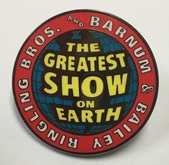RINGLING BROS. AND BARNUM & BAILEY CIRCUS STAFF PIN
Ringling Bros. and Barnum & Bailey Circus is very likely the most well-known circus name in the work. The American circus company, billed as “The Greatest Show on Earth”, was started in 1919 when the circus created by James Anthony Bailey and P. T. Barnum was merged with the Ringling Brothers Circus. The Ringling brothers had purchased the Barnum & Bailey in 1907, but ran the circuses independently until they were merged in 1919.
All circuses suffered during the Great Depression, and the Ringling Bros. and Barnum & Bailey Circus was no exception. However, while the economic plight in the United States forced many circuses to close, the RBBB was able to stay afloat through the difficult times.
World War II also created challenges for the circus. Many of the circus’ personnel were called to serve in the military, and the rail system was needed to transport troops and equipment. President Roosevelt, however, recognized that the country needed entertainment and a diversion from the war to boost morale, so he granted a special dispensation for circuses to move by train.
Probably the largest challenge the circus faced was a fire that occurred during an afternoon performance on July 6, 1944, in Hartford, Connecticut. More than 150 people were killed, and hundreds more were injured. During a subsequent investigation, it was learned that the tent had not been fireproofed. The circus had applied to the Army, which had a priority on material, for enough fireproofing liquid to treat their Big Top tent, but the Army had refused. Still needing to waterproof the tent, the circus had reverted to an older method of waterproofing canvas by using paraffin dissolved in gasoline. While it was an effective waterproofing method, it was also extremely flammable. Afterwards, the courts determined that the circus’ management was negligent, and several Ringling executives served sentences in jail. Additionally, Ringling Brothers' management set aside all profits for the next ten years to pay the civil claims.
In 1956, the circus ended its season early with a final performance in Pittsburgh, Pennsylvania, and President John Ringling North announced that the circus would no longer perform under their own tents. Beginning in 1957, the circus would use permanent venues, such as sports stadiums and arenas, to hold their performances. This is the business model that is still in place today.
The item in my collection was a Staff Pin that was given out to Employees of the show, but not sold to the general public.
All circuses suffered during the Great Depression, and the Ringling Bros. and Barnum & Bailey Circus was no exception. However, while the economic plight in the United States forced many circuses to close, the RBBB was able to stay afloat through the difficult times.
World War II also created challenges for the circus. Many of the circus’ personnel were called to serve in the military, and the rail system was needed to transport troops and equipment. President Roosevelt, however, recognized that the country needed entertainment and a diversion from the war to boost morale, so he granted a special dispensation for circuses to move by train.
Probably the largest challenge the circus faced was a fire that occurred during an afternoon performance on July 6, 1944, in Hartford, Connecticut. More than 150 people were killed, and hundreds more were injured. During a subsequent investigation, it was learned that the tent had not been fireproofed. The circus had applied to the Army, which had a priority on material, for enough fireproofing liquid to treat their Big Top tent, but the Army had refused. Still needing to waterproof the tent, the circus had reverted to an older method of waterproofing canvas by using paraffin dissolved in gasoline. While it was an effective waterproofing method, it was also extremely flammable. Afterwards, the courts determined that the circus’ management was negligent, and several Ringling executives served sentences in jail. Additionally, Ringling Brothers' management set aside all profits for the next ten years to pay the civil claims.
In 1956, the circus ended its season early with a final performance in Pittsburgh, Pennsylvania, and President John Ringling North announced that the circus would no longer perform under their own tents. Beginning in 1957, the circus would use permanent venues, such as sports stadiums and arenas, to hold their performances. This is the business model that is still in place today.
The item in my collection was a Staff Pin that was given out to Employees of the show, but not sold to the general public.
